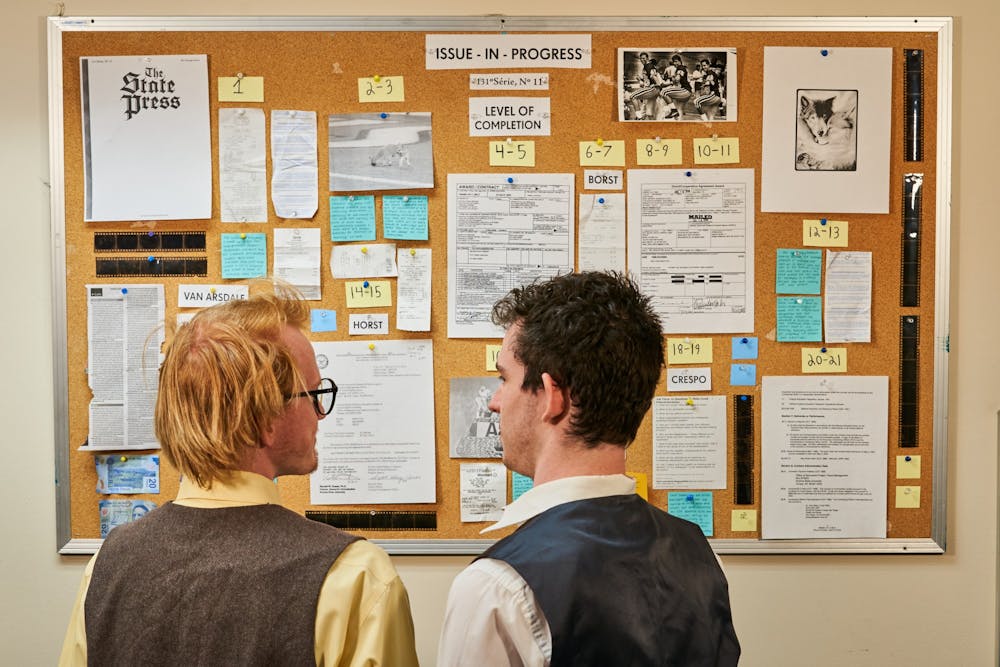Wes Anderson strikes again with “The French Dispatch,” another jewel in his crown of oddly whimsical films. The movie, which was released Oct. 22, is billed as “a love letter to journalists.”
I will be honest — I had never before seen an Anderson film but felt compelled to, once I heard of the film's subject matter. I’m a journalism student, so the chance to see a filmmaker like Anderson, with his borderline absurdist approach to cinema, tackle what I think is one of the most misunderstood professions in the country excited me.
Most cinematic depictions of journalists show an industry full of grand figures akin to superheroes, or in contrast, unscrupulous ones, concerned only with scooping a story, no matter the means. Obviously, this isn’t how most journalists are, and Anderson embraces the quirks and mundanity of storytelling.
The movie centers around a magazine, the French Dispatch of the Liberty, Kansas Evening Sun, and its final issue following the death of its editor, Arthur Howitzer, Jr. (played by Bill Murray), where the magazine reruns three of its best stories and Howitzer’s obituary.
Owen Wilson’s Herbsaint Sazerac kicks off the anthology with a bicycle tour of Ennui-Sur-Blasé (which translates to Boredom-on-Apathy), the fictional city that the magazine’s French offices are based in. It’s the first look at the whimsical, surreal set design that Anderson is famous for.
It feels like a child’s picture book coming to life, the elegant fonts interspersed with the vivid color palette, the old-fashioned bicycle, Wilson’s get-up, and the way he seems to not coast by, but flip through the scenery as it moves behind him.
The acting turns this fantastical world from merely colorful to exceptionally vibrant. As a viewer, you can feel the high journalists know too well that comes with telling a good story. The performances fit perfectly with the film’s overblown tone, and each actor played the part with gusto, striking the perfect balance between serious and cartoonish.
However, I suppose this shouldn’t have been a surprise, considering the overall caliber of “French Dispatch’s” casting. The film is filled to the brim with stars, including the likes of current heartthrob Timothée Chalamet, longtime award-winning performer Jeffrey Wright, and Academy Award winners Benicio del Toro, Tilda Swinton, Frances McDormand and Adrien Brody, and somehow even more.
The three sections of the magazine are the stories set to be rereleased in its final volume. The first, “The Concrete Masterpiece,” stars Brody, Swinton, del Toro and Léa Seydoux in an ensemble, and tells the story of an incarcerated artistic genius, and the crafty art dealer that attempts to make money off of his talent.
Up next is “Revisions to a Manifesto,” which stars Chalamet as a visionary college student trying to "expand access" to the women’s dorm — a premise that continues to get hilariously convoluted as it progresses, eventually ending in a police-student chess standoff. We are told the story through the reporter covering it, played by McDormand.
“The Private Dining Room of the Police Commissioner,” comes after, the last of the three stories, which tells the tale of Lt. Nescaffier (played by Steve Park) and his valiant efforts to save the commissioner’s son, who is held hostage. It also had some of the most comic-like behavior, even turning to animation for some scenes, reminiscent of the “The Adventures of Tintin.”
The anthology wraps up with “Obituary,” where the whole newsroom comes together to write a remembrance for its newly departed editor. This section is filled with newsroom chatter, close colleagues and heartwarming anecdotes, with everything copyedited thoroughly. Honestly, watching this, I wanted nothing more than to go work there myself.
While I thoroughly enjoyed “The French Dispatch,” every now and then I would lose track of where the film had taken me, the plot beginning to feel contrived. But just as it would start to feel as though the film were caught in its own machinations, it would pull back, segueing into an explanation or lighthearted shot, giving me a breath of fresh air.
At the end of the day, do I believe that people should go out and watch this movie? Absolutely.
But learn from my mistake, make sure to fully understand its premise first — otherwise, its whimsy will strike you more like chaos.
Reach the reporter at srkrish5@asu.edu and follow @shradhakrish on Twitter.
Like The State Press on Facebook and follow @statepress on Twitter.
Continue supporting student journalism and donate to The State Press today.




